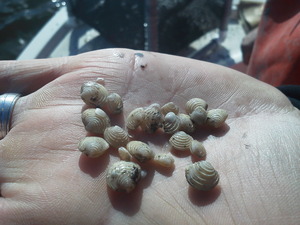|
Sustainably Co-managing Coastal Resources:
The Chilean Valdivian Seascape Model
|

|
|
Valdivia Artisanal Turf fishermen. © Layla
Osman, TNC
|
Chile
has been a global leader in developing co-management approaches for nearshore
species since the early 1990s. After an overfishing crisis led to critical
closures, the Territorial Use Rights for Fishing (TURF) program or AMERB (in
Spanish) was enacted. Chile now has some 800 separate TURFs and 45,000
artisanal fishermen, and each TURF involves a spatial allocation of coastline
and adoption of a community-based catch-share agreement. This is the largest
co-management program in the world and provides secure access to shellfish
resources for groups of artisanal fishermen. Many of the TURFs focus on
managing the harvest of mollusks, include the loco or Chilean abalone, the
country’s most economically important mollusk. The five miles of waters
adjacent the Chilean coast where TURFs exist is an area of regional and
global ecological importance. It is the most productive swath of coastal
waters anywhere in the world, sustained by the powerful upwelling of the
Humboldt Current (mean 3.5g C m2 d-1; maximum 9g C m2 d-1).
TNC’s Valdivian
Coastal Reserve (VCR) comprised of 50,000 hectares of coastal temperate
rainforest in southern Chile, is adjacent to 17 TURFs managed by 10 fishermen
unions. The Chaihuin Fishermen´s Union, made up of 34 families, oversees
three TURFs within estuarine and open rocky coast areas. Over a decade ago, a
locally important mussel shellfishery had collapsed, largely from overfishing
by the community and pollution. Recognizing their role in the collapse, the
community took the initiative to sustainably manage this resource and
instituted a system of catch shares that provides exclusive user rights for
the mussel fishery. Within a section of the 15 hectare estuary, there is a 5
hectare bank of mussels that the families have set aside as a spawner
sanctuary. This designation is in recognition of the mussel bank’s central
role in sustaining the fishery over time. The mussels in the remainder of the
estuary are divided among the 34 families and they have a per-family harvest
limit of 240-500 kilograms per month in summer/winter months. Although the
harvest from the estuary is not enough to fully support each family, they
recognize that the harvest limits and spawner sanctuary are critical for the
stability of their mussel resource – and key to their families’ future
livelihood. The approach holds great promise as a tool for improving
management elsewhere. In fact, TNC is using a similar approach to restoring
clams in Great South Bay, in New York, where a large underwater preserve is
stocked and managed specifically to increase the reproduction of clams for
the entire bay.
There are exciting parallels and lessons from the Humboldt Current Project
that have clear application in many places around the world. The Chilean TURF
model has proven successful, but it still faces several challenges, including
lack of environmental considerations, high operational costs, market
constraints, and weak governance. TNC`s Humboldt Current Project is
partnering with academic institutions and local fishing associations to
demonstrate how proper design, restoration and market incentives can improve
the ecological and economic performance of the fisheries. The Valdivian Seascape
Model, lead by Dr. Layla Osman, expects to export these methods to other
regions of Chile, Peru and other countries of the South Pacific, where ‘open
access’ is still the de facto management regime of coastal fisheries. For
more information, contact Dr. Layla Osman.
Back to top »
Upcoming Events and Conferences
National
Shellfisheries Association (NSA) 104th Annual Conference
March 25-29, 2012
Seattle, WA
Restore
America’s Estuaries (RAE)
6th National Conference on Coastal and Estuarine Habitat Restoration
October 22-27, 2012
Tampa, FL
Conference Theme: "Restoring Ecosystems, Strengthening
Communities"
Note: If you would like to contribute an article or
submit items for the "Looking Ahead" section, please contact Rob Brumbaugh.
Back to top »
Oyster Restoration Publications
and Resources
Oyster
Restoration Working Group Research and Reports
The
Practitioner’s Guide to
Shellfish Restoration: An Ecosystem Services Approach, as
well as back issues of the Shellfish
Restoration Clamor are available online.
Oyster
Restoration Publications and past issues of the CLAMOR
Cool Video!
Delaware
Bay Oyster Restoration
Back to top »
|






